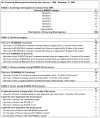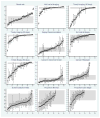Beyond the mammography quality standards act: measuring the quality of breast cancer screening programs
- PMID: 24261339
- PMCID: PMC4113079
- DOI: 10.2214/AJR.13.10806
Beyond the mammography quality standards act: measuring the quality of breast cancer screening programs
Abstract
Objective: A high-quality screening mammography program should find breast cancer when it exists and when the lesion is small and ensure that suspicious findings receive prompt follow-up. The Mammography Quality Standards Act (MQSA) guidelines related to tracking outcomes are insufficient for assessing quality of care. We used data from a quality improvement project to determine whether screening mammography facilities could show that they met certain quality benchmarks beyond those required by MQSA.
Materials and methods: Participating facilities provided aggregate data on screening mammography examinations performed in calendar year 2009 and corresponding diagnostic follow-up, including patients lost to follow-up, timing of diagnostic imaging and biopsy, cancer detection rates, and the proportion of cases of cancer detected as minimal and early-stage tumors.
Results: Among the 52 participating institutions, the percentage of institutions meeting each benchmark varied from 27% to 83%. Facilities with American College of Surgeons or National Consortium of Breast Centers designation were more likely to meet benchmarks pertaining to cancer detection and early detection, and disproportionate share facilities were less likely to meet benchmarks pertaining to timeliness of care.
Conclusion: The results suggest a combination of quality of care issues and incomplete tracking of patients. To accurately measure the quality of the breast cancer screening process, it is critical that there be complete tracking of patients with abnormal screening mammography findings so that results can be interpreted solely in terms of quality of care. The MQSA guidelines for tracking outcomes and measuring quality indicators should be strengthened for better assessment of quality of care.
Figures


References
-
- Ansell D, Grabler P, Whitman S, Ferrans C, Burgess-Bishop J, Murray LR, Rao R, Marcus E. A community effort to reduce the black/white breast cancer mortality disparity in Chicago. Cancer Causes Control. 2009;20:1681–8. - PubMed
-
- Carey LA, Perou CM, Livasy CA, Dressler LG, Cowan D, Conway K, Karaca G, Troester MA, Tse CK, Edmiston S, Deming SL, Geradts J, Cheang MCU, Nielsen TO, Moorman PG, Earp HS, Millikan RC. Race, breast cancer subtypes, and survival in the Carolina Breast Cancer Study. JAMA. 2006;295:2492–502. - PubMed
-
- Cunningham JE, Montero AJ, Garrett-Mayer E, Berkel HJ, Ely B. Racial differences in the incidence of breast cancer subtypes defined by combined histologic grade and hormone receptor status. Cancer Causes Control. 2010;21:399–409. - PubMed
-
- Sabatino SA, CRJ, Uhler RJ, Breen N, Tangka F, Shaw KM. Disparities in mammography use among US women aged 40–64 years, by race, ethnicity, income, and health insurance status, 1993 and 2005. Med Care. 2008;46:692–700. - PubMed
Publication types
MeSH terms
Grants and funding
LinkOut - more resources
Full Text Sources
Other Literature Sources
Medical
Miscellaneous

